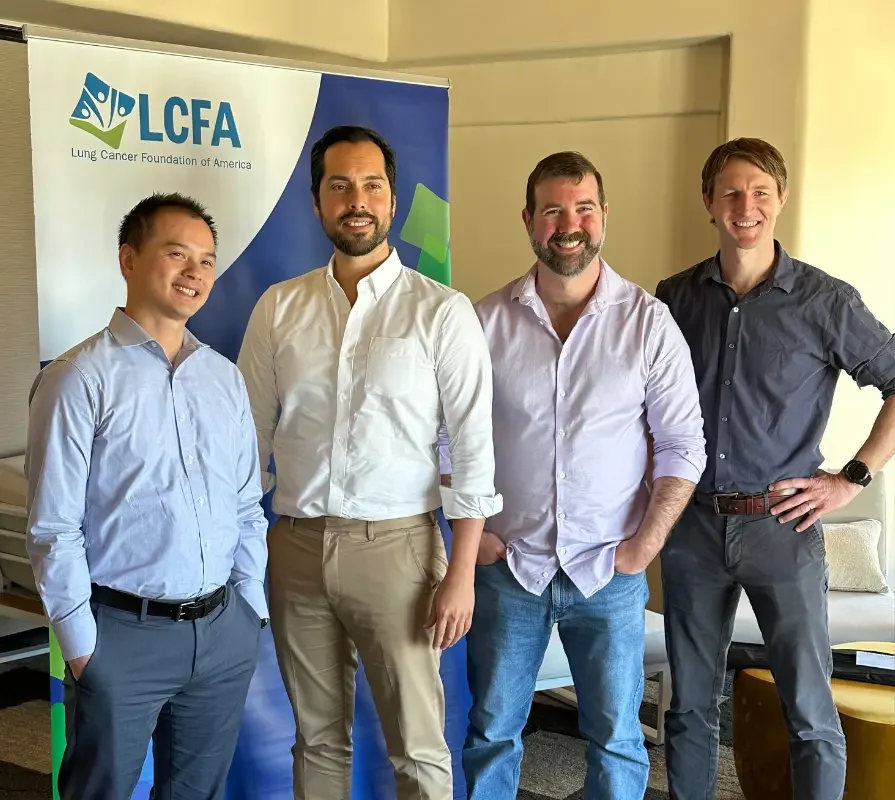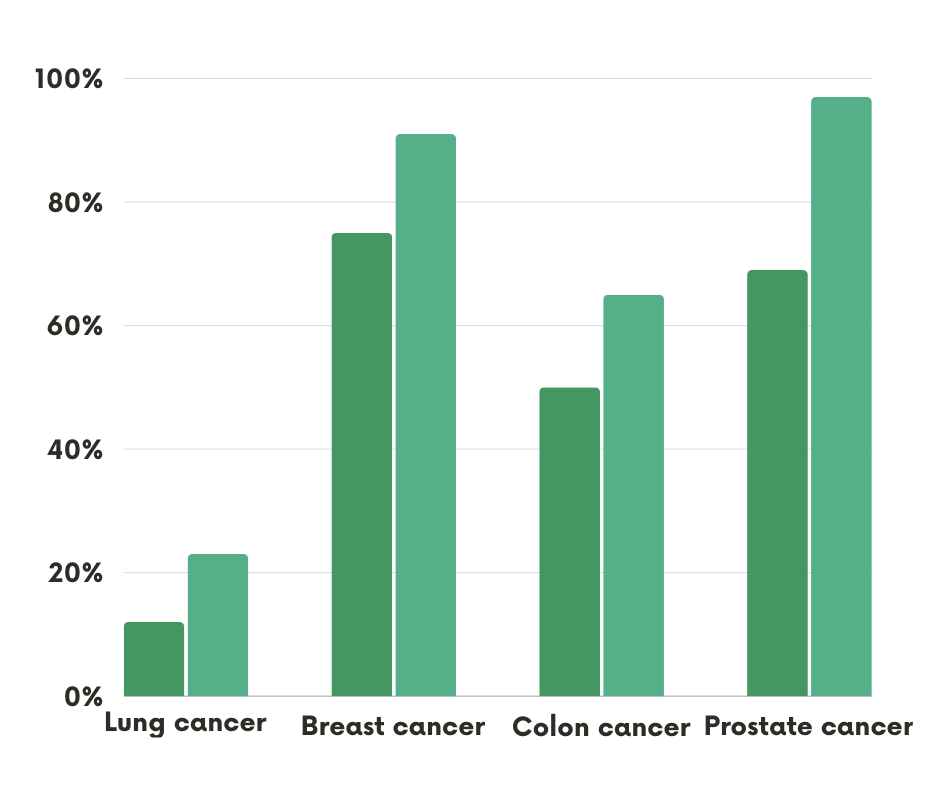
How Grants Move Research Forward
The Progress of Research
Thanks to research, the 5-year survival rates have also been increasing – the overall cancer survival rate was 49% in the mid-1970s. In 2023, the survival rate currently sits at 68%.
The cancer survival rate changes from mid-1970s to 2023 are:
Breast cancer: 75% to 91%
Prostate cancer: 69% at 97%
Colorectal cancer: 50% to 65%
Lung cancer: 12% to 23%

This bar chart compares the 5-year survival rates for lung, breast, colon, and prostate cancer from 1970 to current day.
Funding Fails to Align With Mortality Impact
Lung Cancer: Deadliest but Underfunded
Lung cancer causes more deaths than any other cancer, yet federal funding significantly trails that for breast, colon and prostate cancers. In 2019, lung cancer received just over $300 million in NIH grants – less than half the amount given to leading sites like prostate and breast cancers. Poor five-year survival rates of 23% for lung cancer patients highlight the need for robust funding that enables accelerated research. With more investment, scientists could build on recent gains in targeted therapies and immunotherapies to find new ways to combat lung cancer’s complexity and improve outcomes.

Disparities in Funding Align Poorly with Impact
Current funding disparities send more research dollars toward the most prevalent cancer types, but fail to align with mortality impact. Lung cancer accounts for 25% of all cancer deaths, but only receives about 9% of federal cancer research grants. Meanwhile, breast cancer represents 15% of cancer deaths, yet benefits from over 20% of cancer research funding. More balanced dissemination of grants to match disease burden could rapidly advance lung cancer research. With over 135,000 deaths from lung cancer each year in the U.S., increased funding could lead to breakthrough discoveries that substantially reduce mortality.

Disparities in Funding Looking at Mortality Impact
Did you know?
25% of all cancer deaths are due to lung cancer
9% of total federal research funding goes to lung cancer
15% of all cancer deaths are due to breast cancer
20% of total federal research funding goes to breast cancer
Why Lung Cancer Research Grants Matter
Lung cancer research has made exciting progress. But more funding is really important to speed things up. In the last 10 years, researchers have developed new targeted therapies. These therapies stop specific changes in cells that cause cancer growth. Doctors have also started using immunotherapies like checkpoint inhibitors. These help the immune system attack lung tumors. These new advances give new hope. But big challenges remain. Lung cancer is very complex with hundreds of mutations. More research money can support bigger clinical trials. That will help get emerging therapies to patients faster. It can also uncover new ways to treat lung cancer.
More funding can also attract top scientists to study lung cancer’s complexities. Getting the brightest minds on lung cancer research means the best ideas get tested. Young researchers especially need funding to try new projects early in their careers. With more dollars for cancer research, progress against lung cancer – the deadliest cancer – could speed up dramatically.
The Promise of Fairer Research Funding
Achieving more balanced federal funding based on cancer’s death rates would allow lung cancer research to move faster. Patients fighting this devastating disease would directly benefit from the knowledge and lives saved. Stories of survivors living years longer thanks to new therapies provide hope. More research investment increases chances for new breakthroughs. Giving federal grants fairly based on cancer deaths rather than just cases would save more lives across cancers. Funding research according to disease burden is key to winning the cancer fight.
National Institutes of Health. (2020). Estimates of Funding for Various Research, Condition, and Disease Categories. Retrieved from https://report.nih.gov/funding/categorical-spending#
American Cancer Society. (2022). Cancer Facts & Figures 2022. Retrieved from https://www.cancer.org/research/cancer-facts-statistics/all-cancer-facts-figures/cancer-facts-figures-2022.html
American Lung Association. (2022). State of Lung Cancer 2022. Retrieved from https://www.lung.org/research/sota/lung-cancer
American Cancer Society Cancer Action Network. (2021). Cancer Research Investment Must Match Impact on Patients. Retrieved from https://www.fightcancer.org/releases/cancer-research-investment-must-match-impact-patients
Siegel, R.L., Miller, K.D., Fuchs, H.E., Jemal, A. (2022). Cancer Statistics, 2022. CA Cancer Journal for Clinicians, 72(1), 7-33. https://doi.org/10.3322/caac.21708
National Cancer Institute. (2021). Cancer Moonshot Funding. Retrieved from https://www.cancer.gov/research/key-initiatives/moonshot-cancer-initiative/funding
LCFA Grants push research along
Dr. Kellie Smith, Johns Hopkins University and Dr. Alice Berger, Fred Hutchinson Medical Center, discuss how their LCFA/IASLC Young Investigator grants benefit their research.
LCFA’s Young Investigator Grants
Research grants, like those funded by the Lung Cancer Foundation of America (LCFA), play a crucial role in advancing the world of lung cancer research. These grants provide financial support to scientists and researchers who are dedicated to unraveling the complexities of lung cancer and developing innovative treatments.
By investing in cutting-edge research, LCFA helps to accelerate scientific discoveries, identify new therapeutic targets, and improve patient outcomes.
Through the funding of transformative science, the progress in the field of lung cancer research but also providing hope and access to updated treatment information, clinical trials, and potential breakthroughs for lung cancer patients. The impact of research grants extends far beyond the laboratory, offering a lifeline to individuals and families affected by this devastating disease.
Meet the Researchers
Meet the distinguished investigators awarded Young Investigator grants by LCFA.

